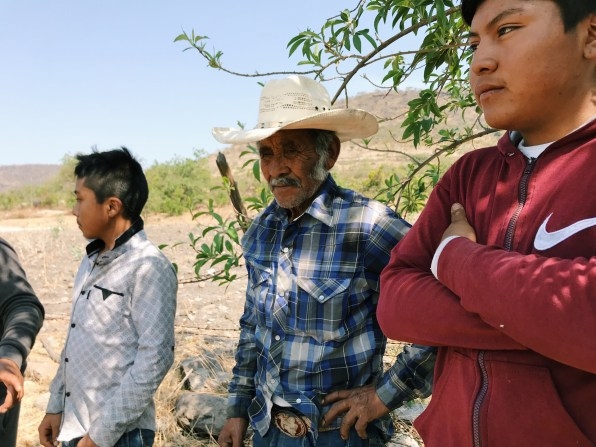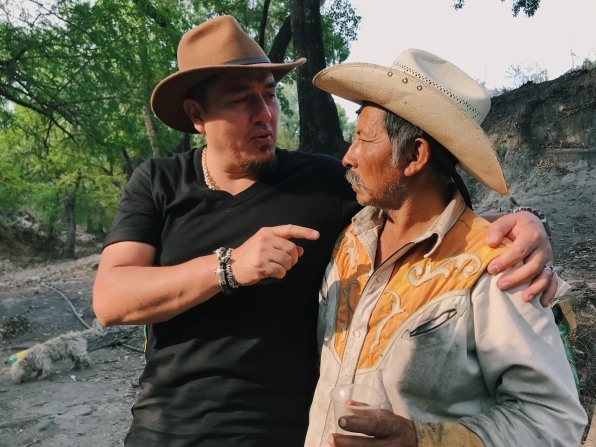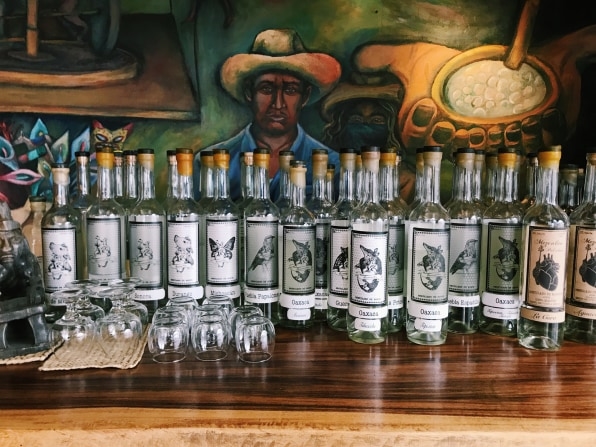In May, I got sunburned standing outside in rural Mexico drinking moonshine from a recycled soda bottle. Sounds like the start to a Cinco de Mayo Hangover movie, but I was there because Erick Rodriguez—the “Indiana Jones of mezcal”—needed to meet with a local distiller outside Puebla, and they’d picked a Catholic feast day at the close of agave season, Día de la Santa Cruz, to do it. Marcelino Garcia’s village was celebrating at his rustic outdoor palenque, passing around plastic jugs of a booze, one of Mexico’s best, that few will ever taste.
Rodriguez, 42, tall and sturdy with a goatee, is a distributor and distiller who now runs the Almamezcalera tasting room in his native Ramos Millán, a neighborhood in Mexico City’s smallest borough, Iztacalco. Clad in cargo shorts and a bevy of silver bracelets, he had driven from Mexico City to buy any mezcal that Garcia would sell. To Rodriguez’s excitement, that ended up being 300 liters made from wild papalome agave, fermented in leather, distilled in a clay pot. On our way out, we made a side trip to see a second mezcalero, Navor. Everyone at his palenque was pretty blotto by then. (A man wearing a gun kept refilling my cup and insisting we both were “chingón.”) Navor didn’t have mezcal for sale, but since he and Garcia currently weren’t speaking, he asked for Rodriguez’s counsel on that. “It’s hard for these older mezcaleros,” Rodriguez explained later. “The more modernized their communities get, the more they sense they’re losing their culture.”

[Photo: Jonathan Frey]
Rodriguez’s ability to find mezcal in the wilds of Mexico that tastes like barbecue sauce or washed-rind cheese has earned him an international following. He’ll pour you samples of a dozen, and somehow, no two are alike. His personal brand, Almamezcalera, has been behind the bar at the world-class Mexico City restaurant Pujol and Noma’s $600-a-head pop-up in Tulum. He’s hooked producers up to collaborate with brands like Wahaka and Clase Azul. (In fact, a Clase Azul rep tells me initially Rodriguez was their mezcal program.)
However, with Big Liquor now salivating over the untapped market—mezcal is the fastest-growing category, but barely 1/50th tequila’s size—Rodriguez’s job of selling unique mezcals practically lost to time for up to $1,000 a bottle suddenly gains a cultural imperative: Get these struggling mezcaleros’ excellent products into eager hands, and he protects their communities, the land’s rare agaves, and the craft itself.
“Agave producers are a species in extinction,” Raul Garcia Quirarte, president of Mexico’s National Committee for Agave Production, bleakly told Businessweek last October. The industry naturally cycles through boom-bust cycles because it’s among Earth’s slowest-growing plants: seven years for the fast ones to reach maturity. Of Mexico’s 200 species, blue agave is used for tequila, and another three dozen or so routinely become mezcal. Too much demand could decimate the wild varieties mezcaleros have harvested for decades, like tepeztate, which sometimes takes 35 years to ripen. Coincidentally, wild agave is also what today’s consumer is told best expresses mezcal’s subtleties.
Every major brand has made social-responsibility pledges about sustainability and reforestation. (Clase Azul, for instance, plants 10 times as much agave as it uses.) But even putting tons of espadín, the kudzu of mezcal agaves, in the ground tomorrow will yield a useless field of spiny succulents until about 2027. “If demand skyrockets, that community can lose their tie to the land,” says Chantal Martineau, author of How the Gringos Stole Tequila. “The biocultural threat is the greatest risk.”
She notes commodification’s heavy toll on tequila (which technically is a mezcal subtype). The price of blue agave, a variety that takes about six years to mature, has quintupled since 2016; a kilo that was 4 pesos now costs 22. Unsurprisingly, plant theft is up and Mexico’s cartels have entered the picture. Meanwhile, price swoons hurt multinationals like José Cuervo and Sauza less than small producers, because they buy agave contracts in bulk way in advance. (Sadly, this has morphed blue agave into a genetic monoculture extremely susceptible to disease—Mexico’s version of the Cavendish banana, basically.) To meet the global tequila demand, farmers are quietly harvesting two- and three-year-old agaves. These haven’t developed enough sugars yet, so a disproportionally greater number are required to produce the same volume. It’s like paying off debt by borrowing more money.

Pink tequilas, diamond-encrusted bottles
Tequila has been eating its young for years. “Even in the ’70s, there was no focus on sustainability, no focus on the process, no focus on the land, no focus on protecting the original craft,” Martineau says. “The focus was only on protecting the brands.” Tahonas where agave hearts were crushed by millstone in pits (a process still used for mezcal) were replaced by train-size diffusers and autoclaves.
Today’s fastest-growing segment is “ultra-premium,” a class filled with gimmicky tequilas that are dyed pink, distilled and filtered 12 separate times, or sold in $3.5 million diamond-encrusted bottles. “Agavodkas” barely touched by human hands dominate the opposite end. In between used to be everyone else. However, while Mexico had 3,100 tequila brands in 2011, it’s down to just 1,600 today. But during that eight-year decline, tequila production increased by 48 million liters. Mezcal production is now climbing faster than tequila’s ever did, from 500,000 liters in 2009 to more than 4 million today, and it’s predicted to triple again by 2022.
“Having observed the tequila industry for the better part of 20 years, I’d hate to see mezcal make the same mistakes,” says Mike Morales, founder of the popular spirits-review site Tequila Aficionado, who thinks Jack Daniels owner Brown-Ferman’s 2006 purchase of Herradura was the crossing of the Rubicon. “Everyone who enjoys a good artisanal mezcal is looking at these companies and holding their breath.”
When I visited Rodriguez’s tasting room back in May, he was in surprisingly good spirits for a guy who’d, in fact, just been robbed at gunpoint the night before. As he handed me samples—a ginger pechuga, a San Luis Potosí bottle that tasted like bell pepper and pickles, a concoction infused with enough marijuana to turn green—he explained he’d emptied the office safe into his bag, then gotten jumped in the street. “Eight years of savings,” he added, which he was withdrawing to buy a nearby property and scale up operations.
Maybe it’s too on the nose, but I couldn’t overlook the symbolism of mezcal being hurt by greedy interlopers. Rodriguez’s camp of purists argues even the Mexican government is dismissing their interests. In 2017, long-awaited revisions to mezcal’s production standards were finally released, and they read like a carbon copy of tequila’s. The government broke mezcal into three commercial categories: plain “mezcal” (which brands understandably ran from), then confusingly “artisanal” (the vast majority of mezcals), and “ancestral” (almost none, thanks to rigorous criteria). Consumers can hardly differentiate the last two, and “mezcal” is actually allowed to use diffusers and autoclaves, despite aggressive lobbying by small producers to outright prohibit them. To add insult to injury, the government also stuck gas-powered shredders in the subsidy packages it awarded registered mezcal brands.
Personally, Rodriguez would prefer a subsidy to help him transport mezcal from impassible backcountry ravines to his Mexico City warehouse. Every bottle he sells also incurs a 50% liquor tax and 16% VAT. His mezcaleros receive between 30 and 60 percent of whatever’s left after taxes and transit and storage costs. When he raises extra money, it often goes to the nonprofit he founded to improve mezcaleros’ villages—expand a palenque, or buy computers for the school. At least business is solid: Back in April, he sold out within an hour at Chicago’s Mexico in a Bottle expo.

Mediocre mezcal gluts the market
Right now, a good-size mezcal producer distills maybe 200,000 liters a year—absolute peanuts in the alcohol world. It’s enough for some to dismiss Big-Liquor-takeover fears as alarmist. But to Rodriguez and others, the battle is over spending habits, and America’s ever-growing glut of mediocre mezcal cocktails worries them. “What if Chili’s starts serving one?” veteran New York bar owner Eben Freeman recently asked.
Freeman was joking, kind of. But the chain Rosa Mexicano actually just hired a “master mezcalier” to age mezcal in-house (in bourbon barrels!). This season, the L.A. Galaxy signed up El Silencio as the world’s first-ever pro sports team “mezcal sponsor,” adding an obligatory hidden speakeasy to their stadium. El Silencio followed this news by selling itself to beer-and-wine conglomerate Constellation Brands. Last year, Bacardi took a minority stake in Ilegal. And in 2017, everyone was stunned when giant Pernod Richard acquired Ron Cooper’s beloved Del Maguey, the brand behind the modern-day mezcal wave.
Pernod reportedly guaranteed Cooper autonomy. Martineau, who coauthored Cooper’s 2018 memoir Finding Mezcal, says he continues to manage operations conscientiously, opting for “more and more tiny palenques” instead of one big megafactory. However, at 76, Cooper is almost retired—what happens then?
Successful brands that attract corporate buyers probably, if they have a quality product, source alcohol from traditional palenques. But assuming a happy ending would be wrong. Before mezcal, Constellation Brands tried “making better-quality craft beer” by acquiring Ballast Point. Sales subsequently fell, brewing operations were consolidated, and employees got hit with layoffs. Starbucks made similar promises about having “literally changed the face of” coffee farms when it entered Nariño, Colombia—until farmers denied receiving any benefits from the company.
In Oaxaca, “world capital of mezcal,” plenty of palenqueros have become rich. There’s also a Disneyfied tourist highway, the Ruta del Mezcal, that cuts through private lands. Lately, distilleries have started adding parking lots and other structural improvements, according to Alvin Starkman, a longtime mezcal expert and guide in Oaxaca. Meanwhile, he’s noticed the alcohol content slipping in their mezcal, the 50% benchmark giving way to bottles with 37 or 38 percent that “hurt mezcal’s reputation,” he says. “Right now, brands are split between altruists who want to help the palenquero, and entrepreneurs who try to squeeze him as much as possible.”
Luckily, Mexicans have spent generations distilling even funkier spirits like raicilla, bacanora, and pulque—all of which are making cameos in America’s bar scene. Rodriguez himself is now producing sotol, a liquor from desert spoon plants. Some Oaxacan mezcaleros heard the rumor and asked him to teach them how. “Sotol is all they have left,” he says. “They can’t just go get more agave.”
Earlier, Rodriguez had sort of humblebragged about being godfather to “dozens” of his master distillers’ kids. I didn’t get what he meant at first. It sounded like bragging you’re an agent who dates your own models. Then I realized he was explaining the predicament these farmers are in: “If they need something fixed, they call me. I’m the only one who can help, in their minds. Not because I have money”—he laughs at that thought—”but because I know them and get their respect.”
This story has been updated.
(28)